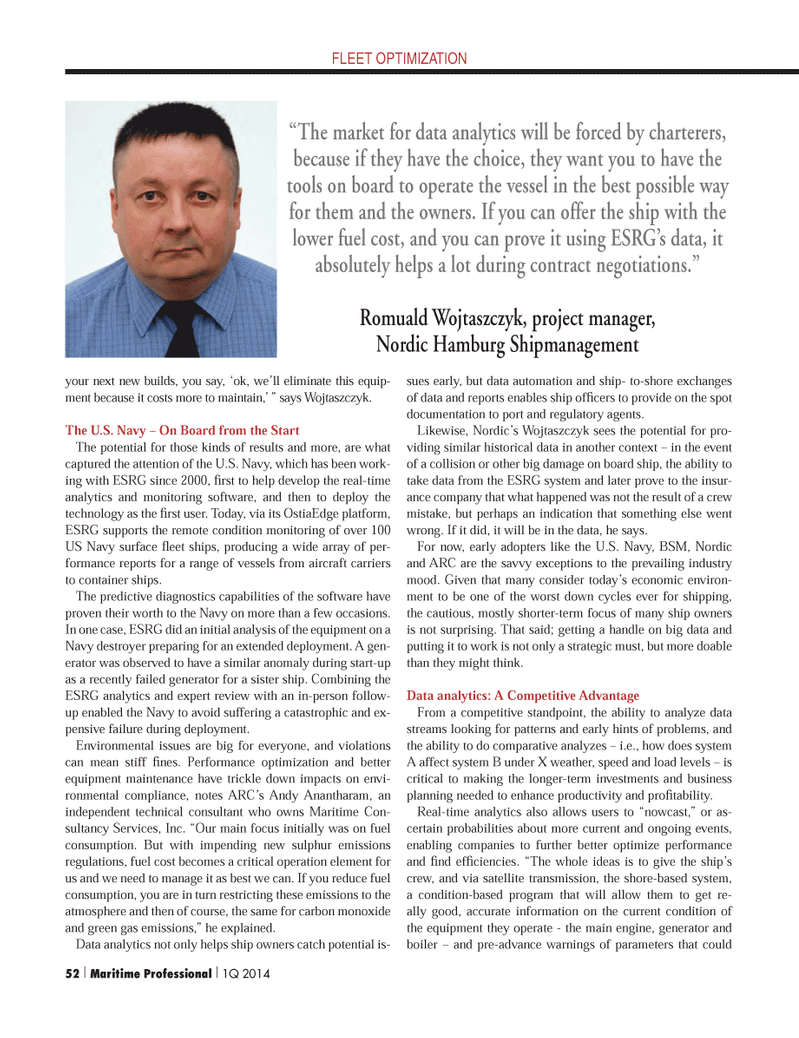
Page 52: of Maritime Logistics Professional Magazine (Q1 2014)
The Energy Edition: Exploration, Production & Transportation
Read this page in Pdf, Flash or Html5 edition of Q1 2014 Maritime Logistics Professional Magazine
FLEET OPTIMIZATION your next new builds, you say, ‘ok, we’ll eliminate this equip- ment because it costs more to maintain,’ ” says Wojtaszczyk.
The U.S. Navy – On Board from the Start
The potential for those kinds of results and more, are what captured the attention of the U.S. Navy, which has been work- ing with ESRG since 2000, fi rst to help develop the real-time analytics and monitoring software, and then to deploy the technology as the fi rst user. Today, via its OstiaEdge platform,
ESRG supports the remote condition monitoring of over 100
US Navy surface fl eet ships, producing a wide array of per- formance reports for a range of vessels from aircraft carriers to container ships.
The predictive diagnostics capabilities of the software have proven their worth to the Navy on more than a few occasions.
In one case, ESRG did an initial analysis of the equipment on a
Navy destroyer preparing for an extended deployment. A gen- erator was observed to have a similar anomaly during start-up as a recently failed generator for a sister ship. Combining the
ESRG analytics and expert review with an in-person follow- up enabled the Navy to avoid suffering a catastrophic and ex- pensive failure during deployment.
Environmental issues are big for everyone, and violations can mean stiff fi nes. Performance optimization and better equipment maintenance have trickle down impacts on envi- ronmental compliance, notes ARC’s Andy Anantharam, an independent technical consultant who owns Maritime Con- sultancy Services, Inc. “Our main focus initially was on fuel consumption. But with impending new sulphur emissions regulations, fuel cost becomes a critical operation element for us and we need to manage it as best we can. If you reduce fuel consumption, you are in turn restricting these emissions to the atmosphere and then of course, the same for carbon monoxide and green gas emissions,” he explained.
Data analytics not only helps ship owners catch potential is- sues early, but data automation and ship- to-shore exchanges of data and reports enables ship offi cers to provide on the spot documentation to port and regulatory agents.
Likewise, Nordic’s Wojtaszczyk sees the potential for pro- viding similar historical data in another context – in the event of a collision or other big damage on board ship, the ability to take data from the ESRG system and later prove to the insur- ance company that what happened was not the result of a crew mistake, but perhaps an indication that something else went wrong. If it did, it will be in the data, he says.
For now, early adopters like the U.S. Navy, BSM, Nordic and ARC are the savvy exceptions to the prevailing industry mood. Given that many consider today’s economic environ- ment to be one of the worst down cycles ever for shipping, the cautious, mostly shorter-term focus of many ship owners is not surprising. That said; getting a handle on big data and putting it to work is not only a strategic must, but more doable than they might think.
Data analytics: A Competitive Advantage
From a competitive standpoint, the ability to analyze data streams looking for patterns and early hints of problems, and the ability to do comparative analyzes – i.e., how does system
A affect system B under X weather, speed and load levels – is critical to making the longer-term investments and business planning needed to enhance productivity and profi tability.
Real-time analytics also allows users to “nowcast,” or as- certain probabilities about more current and ongoing events, enabling companies to further better optimize performance and fi nd effi ciencies. “The whole ideas is to give the ship’s crew, and via satellite transmission, the shore-based system, a condition-based program that will allow them to get re- ally good, accurate information on the current condition of the equipment they operate - the main engine, generator and boiler – and pre-advance warnings of parameters that could “The market for data analytics will be forced by charterers, because if they have the choice, they want you to have the tools on board to operate the vessel in the best possible way for them and the owners. If you can offer the ship with the lower fuel cost, and you can prove it using ESRG’s data, it absolutely helps a lot during contract negotiations.”
Romuald Wojtaszczyk, project manager,
Nordic Hamburg Shipmanagement 52 | Maritime Professional | 1Q 2014
MP Q1 2014 50-63.indd 52 2/26/2014 1:34:08 PM

 51
51

 53
53
